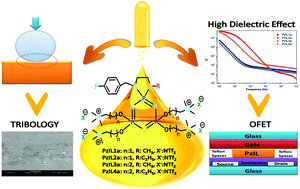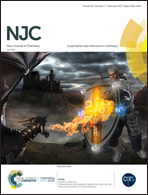Synthesis, and spectroscopic, thermal and dielectric properties of phosphazene based ionic liquids: OFET application and tribological behavior†
Abstract
Mono(4-fluorobenzyl)cyclotriphosphazene derivatives with (dimethylamino)ethoxy (Pz1a–2a) and (dimethylamino)propoxy (Pz1b–2b) chains were synthesized. The chain nitrogen atoms of fully substituted cyclotriphosphazene compounds were quaternized by treatment with CH3I to give phosphazene based ionic liquids (PzILs), PzIL1–PzIL4. Subsequent metathesis with LiN(SO2CF3)2 gave the salts, PzIL1a–PzIL4a. The structures of the PzILs were confirmed by elemental analyses, FTIR and 1H, 13C{1H}, and 31P{1H} NMR techniques. The thermal properties of all compounds were described using thermogravimetric analysis (TGA). These newly synthesized PzILs were used as the dielectric layer in organic field effect transistors (OFETs). Both dielectric and OFET characterization were performed. Because of the high dielectric effect of the PzILs, the fabricated OFETs operated in the low voltage range. Furthermore, a sliding wear test was conducted at room temperature using an AA7075 disc specimen against a stationary 100Cr6 steel ball. The wear protection of the PzILs and 15W40 engine oil was determined by considering the volume loss of AA7075. The lowest coefficient of friction (COF) and wear loss were obtained with PzIL4a.



 Please wait while we load your content...
Please wait while we load your content...